UNIT 1:CONCEPT OF ECOSYSTEM
Key unit competence: Explain components of an ecosystem and how energy flows in an ecosystem.
Introductory activity 1
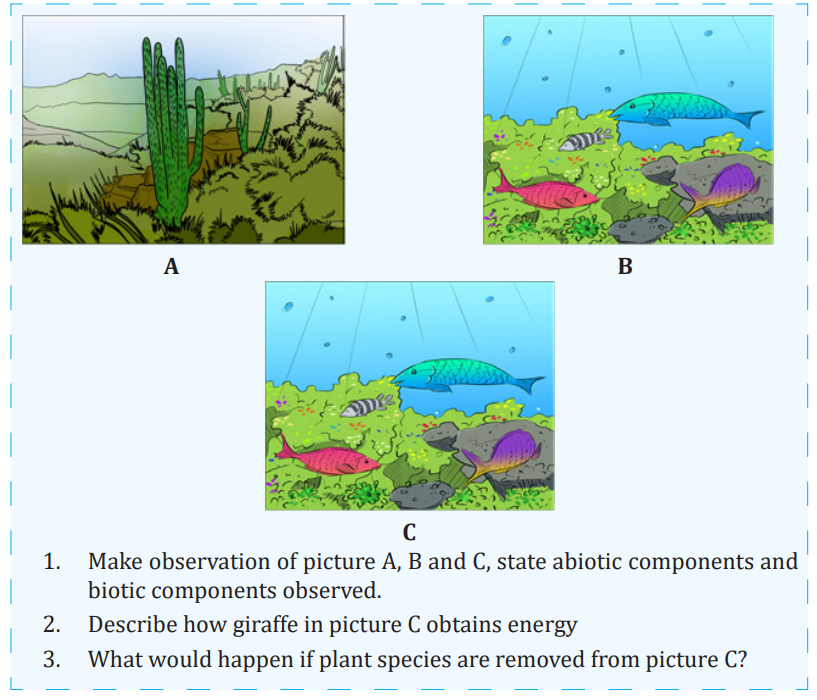
1.1 Description of an ecosystem
1. Observe carefully the diagram below, and answer the questions that follow

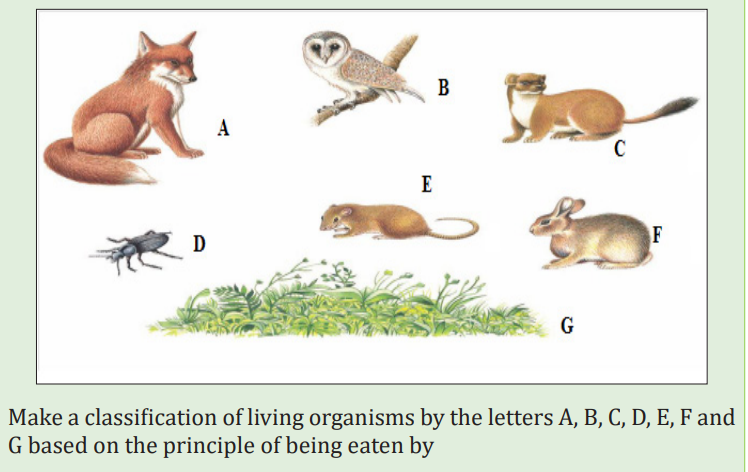
1.1.1 Definition of ecosystem
Different concepts define levels in ecology. From the low to high level, the concepts include:
a. Species
Species such as bees in figure 1.1 is defined as a group of organisms that can breed to produce fertile offspring.

Figure 1.1: Species of bee
b. Population
A population is a group of organism of the same species which live in the same habitat at the same time where they can freely interbreed. Elephants such as those indicated in figure 1.2 constitute a population.
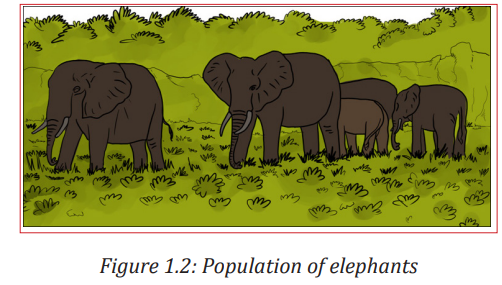
c. Community
In ecology, a community consists of all populations of different species living and interacting at a certain level in the same ecosystem. Animals indicated in the figure 1.3 interact and share the same ecosystem

d. Niche
A niche refers to the role played by a species in its ecosystem. It includes all the ways that the species interacts with the biotic and abiotic factors of the environment. Two important aspects of a species’ niche are the food it eats and how the food is obtained. Birds (figure 1.4) live in the same ecosystem, but they have different adaptations for food. For example, the longest slender beak of the nectarivore allows it to sip the nectar from flowers; the short study beak of the granivore allows it to crush hard and tough grains.

The habitat is the physical environment in which a species lives and to which it is adapted. A habitat’s features are mainly determined by abiotic factors such as temperature and rainfall, which in turn have an influence on the traits of the organisms that live in that habitat. A habitat is also influenced by biotic factors as it may contain many different species. However, in the same habitat, two different species cannot occupy the same niche in the same place for very long. This is known as the competitive exclusion principle. If two species were to occupy the same niche, they would compete with one another for the same food and other environmental resources leading to the extinction of the weaker species.
e. Ecosystem
An ecosystem is a natural unit consisting of all the living organisms in an area functioning together with all the non-living physical factors to bring about a stable or self sustaining unit. The concept of an ecosystem can apply to units of different sizes. For example, a large body of fresh water could be considered an ecosystem, and so could a small piece of dead wood. Both contain a community of species that interact with one another and with the abiotic components of their environment.

f. Biomes
A biome is a broad regional type of an ecosystem characterized by distinctive climate and soil conditions and a distinctive kind of biological community adapted to those conditions. Biomes are of various types including terrestrial and aquatic biomes.
Terrestrial biomes consist of all the land areas on Earth where organisms live. The distinguishing features of terrestrial biomes are determined mainly by climate. The dominant terrestrial biomes include; tundra, temperate forests, grasslands, temperate, tropical deserts, tropical forests and grasslands (Figure 1.6).


Aquatic biomes occupy the largest part of biosphere. These are divided into two, i.e. marine and freshwater. The marine biomes e.g. oceans which is the biggest of the two (Figure 1.7 below) have a very high salt concentration and have fauna adapted to them. The fresh water biomes such as lakes and rivers have a low salt concentration of less than 1%.
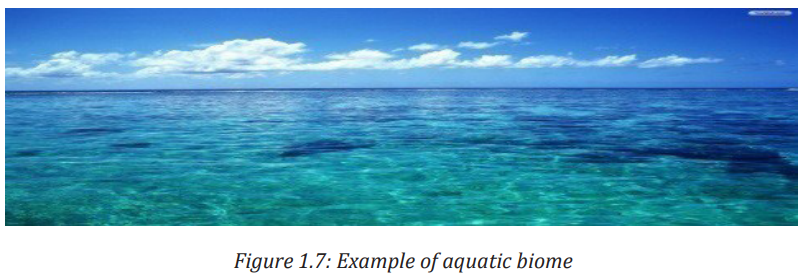
g. Biosphere
The biosphere is the portion of Earth inhabited by life and which represents the sum of all communities and ecosystems.
1.1.2 Components of an ecosystem
In an ecosystem, living organisms have feeding relationships. In terms of sources of food, organisms are classified as; producers, consumers, or decomposers.
- Producers are organisms that can manufacture their own food. They include; green algae, green plants and other autotrophs that are able to make their own food through photosynthesis or chemosynthesis
- Consumers are organisms that obtain food from other organisms because they cannot make their own food. Based on their level of feeding, consumers are classified as primary consumers when they feed directly 7 on plants. Primary consumers include herbivorous or omnivorous animals. Consumers are also classified as secondary consumers, when they feed directly on primary consumers. Secondary consumers include carnivorous animals. Tertiary consumers are consumers that feed directly on secondary consumers and are top carnivorous or omnivorous animals.
- Decomposers are organisms that break down the tissues of dead organisms into simpler substances, for example bacteria and fungi that break down dead plants and animals into compounds of carbon and nitrogen. These compounds are released into the soil to be used by plants and animals for growth.
In a food chain, producers such as plants produce their own energy without consuming other life forms. They gain their energy from conducting photosynthesis via sunlight.
Consumers exist on the next level of the food chain and they are three main types of consumers namely herbivores, carnivores and omnivores. Consumers get the energy by feeding on plants or by eating other carnivores or herbivores.
In an ecosystem, life is influenced by biotic and abiotic factors.
a. Abiotic factors
Sunlight: Sunlight plays an important role in the species composition and development of vegetation. Sunlight is abundantly received on the surface of the earth from solar energy and it is used by primary producers to do photosynthesis. Sunlight intensity shows special variations due to the factors like atmospheric water layer, particles dispersed in the air, etc. Furthermore, the vegetation of an area may also affect the light intensity. In deep shade under trees, or under water, light becomes limiting factor below which photosynthesis is not sufficient for effective growth.
Temperature: Temperature is a measurement of the degree of heat. Like light, heat is a form of energy. The radiant energy received from the sun is converted into heat energy. Heat is measured in calories. The temperature at which physiological processes are at their maximum efficiency is called optimum temperature.
The minimum, optimum and maximum temperatures are called cardinal temperatures. The cardinal temperature varies from species to species and in the same individual from part to part. The distributions of plants, animals are also influenced by temperature.
Water: Water is an indispensable part of land contributing to soil productivity, and the well beings of organisms. All physiological processes take place in the medium of water. For example, cellular protoplasm is made up mostly of water contributing to the maintenance of cells and hence the entire living organism survives.
Rainfall: The rainfall provides water to plants and animals, and determines the types of vegetation in a given region. For example, the evergreen forests are found in tropical regions. Changes in rainfall influence the vegetation types in different parts of the earth, and in turn, vegetation causes changes in the types of forests, animals and birds. The quantity of water that a soil holds or that infiltrates into the soil depends upon the properties of soil and type and density of vegetation covering it. In a bare area, the rain drops beat the compact surface of the soil and loosen the soil particles which are washed away.
Wind: Air in motion is called wind. It modifies the water relation and light conditions of a particular region, and brings about a number of physical, anatomical and physiological changes of plants. Such changes are breakage and uprooting of plants, deformation, erosion and deposition of different organic particles. The wind accelerates transpiration, removes solid moisture and at high velocities causes soil erosion, which contributes to the removal of the surface soil, rich in organic matter and fine mineral particles.
Humidity: Humidity is greatly influenced by intensity of solar radiation, temperature, altitude, wind, and water status of soil. Low temperature causes higher relative humidity by decreasing the capacity of air for moisture. Processes as transpiration, absorption of water are influenced by atmospheric humidity.
Atmospheric Gases: Some principal gases like nitrogen, oxygen, carbon-dioxide, helium, hydrogen, methane, and ozone are found in atmosphere. In addition to these gases, there is water vapor. Industrial gases, dust, smoke particles, microorganisms are present in the atmosphere. These gases have different influences on the environment and hence on the living things.
Soil is often considered an abiotic factor since it is mostly made up of small particles of rock (sand and clay) mixed with decomposed plants and animals. Plants use their roots to get water and nutrients from the soil. Soils are different from place to place this can be a big factor in which plants and animals live in a certain area.
There are other examples of abiotic factors such as, salinity, pressure, light, wind and pH
Biotic Factors
The biotic factors constitute the living organisms of the environment and their direct or indirect interactions. The population occurring together in an area interacts with each other in several ways including predation, competition for mating and for different natural resources including; food, water and oxygen. The biotic factors include producers, consumers and decomposers
1. Producers. All plants, such as grass and trees, green algae are producers. These organisms absorb the sun’s energy and convert the energy into food for themselves, allowing them to grow larger, make flowers and seeds, etc.
2. Consumers. These organisms, mostly animals, zooplankton eat producers and/or other animals. They may also eat decomposers. Two examples of consumers are cows (eat plants) and lions (eat animals). Consumers that only eat plants (herbivores) are often known as primary consumers.
3. Decomposers. These organisms break down dead material (such as a fallen tree) into soil and return nutrients to the soil so they can be re-used by producers to create food. An example of a decomposer is a bacterium
1.1.3 Types of ecosystem
They are two major classifications of ecosystems: natural ecosystem and artificial ecosystem. Natural ecosystems are those ecosystems that are capable of operating and maintaining themselves without any major interference by man.
Natural ecosystems are furthermore classified into terrestrial ecosystems including; forest, grassland and desert, and in Aquatic ecosystems including freshwater ecosystem such as; ponds, lakes, rivers and marine ecosystems such as ocean, sea or estuary.
Artificial Ecosystem are those ecosystems maintained by the intervention of humans. They are manipulated by man for different purposes including; croplands, artificial lakes and reservoirs, townships and cities.
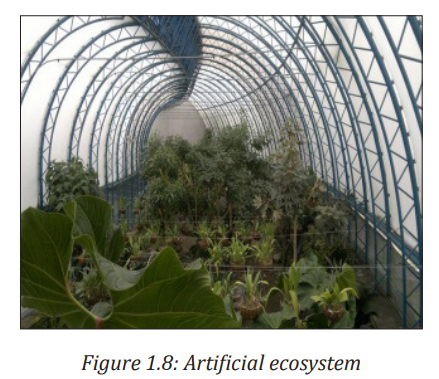
Application activity 1.1
1. Carry out a fieldwork in school environment or outside the school. Identify three aquatic and three terrestrial ecosystems found in Rwanda
2. Make a brief description of an ecosystem
1.2 Energy flow in ecosystems
Activity 1.2
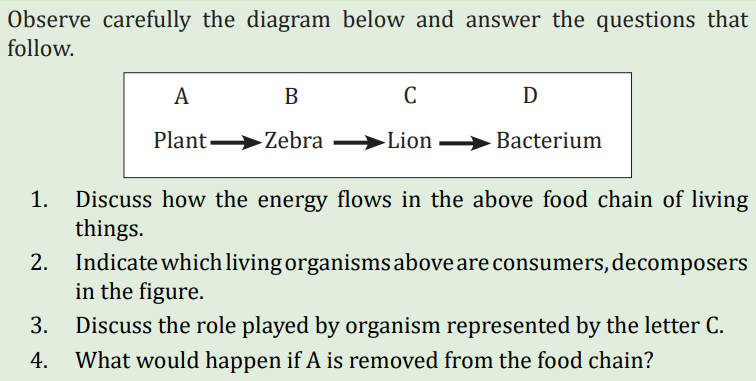
Energy enters in an ecosystem in the form of sunlight or chemical compounds. Some organisms including plants and green algae use sunlight energy to make their own food.
Other organisms get energy through food by eating producers or consumers or by decomposing producers and consumers.
1.2.1 Food chains and food webs
Food chains and food webs are diagrams that represent feeding relationships. They show who eats who. In this way, they model how energy and matter move through ecosystems.
a. Food chains
A food chain represents a single pathway through which energy and matter flow through an ecosystem. Food chains are generally simpler than what really happens in nature. Most organisms consume and are consumed by more than one species.
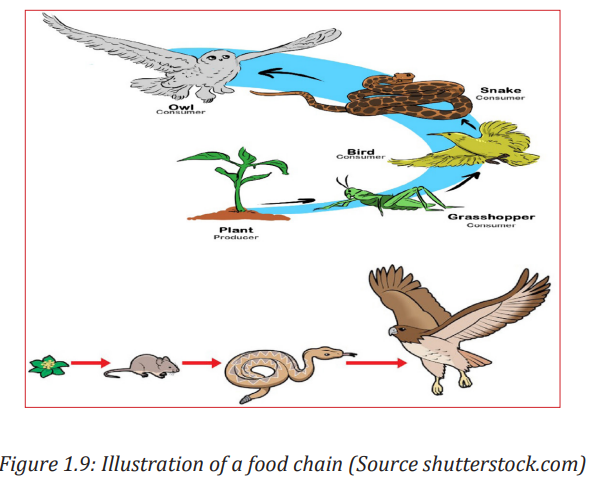
b. Food webs
A food web represents multiple pathways through which energy and matter flow through an ecosystem. It includes many intersecting food chains. It demonstrates that most organisms eat, and are eaten, by more than one species.

c. Trophic levels
The feeding positions in a food chain or web are called trophic levels. The different trophic levels are defined in the table below (Table 1.1). All food chains and food webs have at least two or three trophic levels, the maximum being of four trophic levels. Many consumers feed at more than one trophic levels. Humans, for example, are primary consumers when they eat plants, secondary consumers when they eat meat from primary consumers, and are tertiary consumers when they eat meat of secondary consumers.
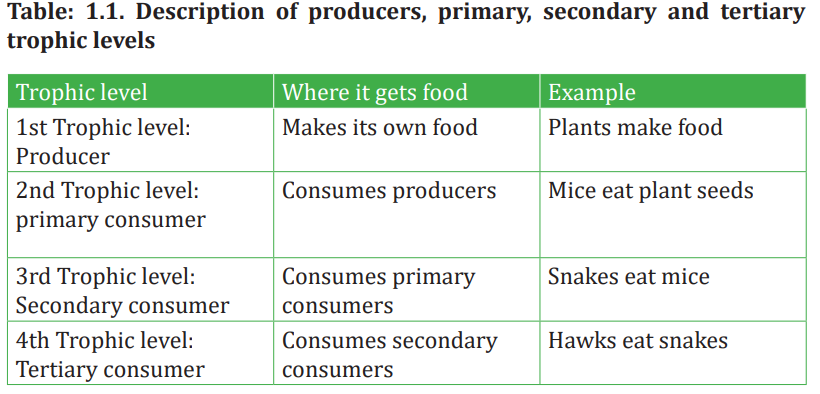
1.2.2 Ecological pyramids
Ecological pyramid is a graphical representation in the form of a pyramid showing the feeding relationships of groups of organisms. It is often represented in a way that the producers are at the bottom level and then proceeds through the various trophic levels in which the highest is on top. There are 3 types of ecological pyramids: pyramid of numbers, pyramid of biomass and pyramid of energy.
a. Pyramid of numbers
Pyramid of numbers is a graph representing the total number of individuals present at each trophic level. This type of pyramid can have two different forms depending on the number of organisms: upright and inverted. In an upright pyramid of numbers, the number of organisms generally decreases from the bottom to top. This generally occurs in grassland and pond ecosystems where plants occupy the base of the pyramid. An inverted pyramid of numbers, on the other hand, is just the opposite of the upright one. It is usually observed in tree ecosystems with the trees as the producers and the insects as consumers.
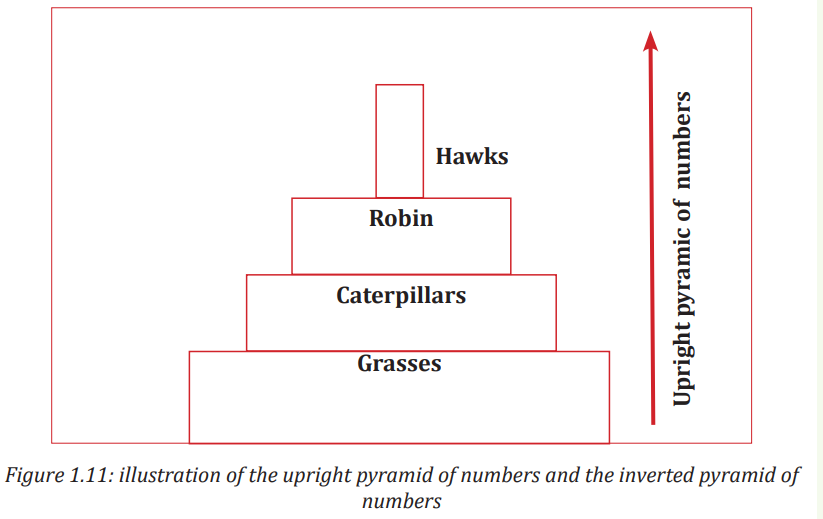
b. Pyramid of biomass
Biomass is defined as the amount of biomass per unit area product of the living material present in an organism and the total number of organisms present in a specific trophic level. In less complicated terms, it refers to the food available for the succeeding trophic level.
A pyramid of biomass is a depiction of the amount of food available and how much energy is being passed on at each trophic level. Most the biomass that animals consume is used to provide the energy, converted to new tissues, or just remain undigested.
Most of the time, pyramids of biomass are in a true pyramidal shape with biomass in the lower trophic levels are greater than the trophic levels above them. Like the pyramid of numbers, the pyramid of biomass can either have two forms: upright and inverted. Usually, terrestrial ecosystems are characterized by an upright pyramid of biomass having larger base for primary producers with the smaller trophic levels for consumers located at the top (figure located left). Aquatic ecosystems are the complete opposite as they will assume the inverted structure of the pyramid. This is because the phytoplankton producers with generally smaller biomass are located at the base while the consumers having larger biomass are located at the top of the pyramid (figure located right)
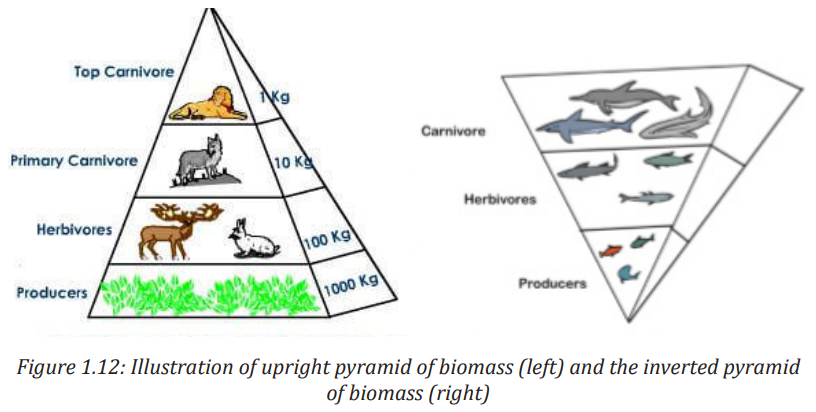
In other words, the phytoplankton has a short turnover time, which means they have a small standing crop compared to their production. The turnover time is calculated by the following formula:

1.2.3 Pyramid of energy
The pyramid of energy shows the overall energy in the ecosystem and how much energy is required by organisms as it flows up the higher trophic levels. This pyramid shows that energy is transferred from lower trophic levels with 15 more amount of energy (producers) to higher ones (consumers) and converted in the biomass. Therefore, it can be concluded that organisms found at the highest trophic levels of shorter food chains bear greater amount of energy than the ones found in longer ones. Unlike the first two ecological pyramids, the pyramid of energy is always illustrated in an upright position, with the largest energy carriers at the base.
The pyramid shows the total energy stored in organisms at each trophic level in an ecosystem.
Starting with primary consumers, each trophic level in the food chain has only 10 percent of the energy of the level below it (Figure 1.13). The energy available at a given trophic level is measured in Kilojoules per square metre per year (kJm-2Y-1).
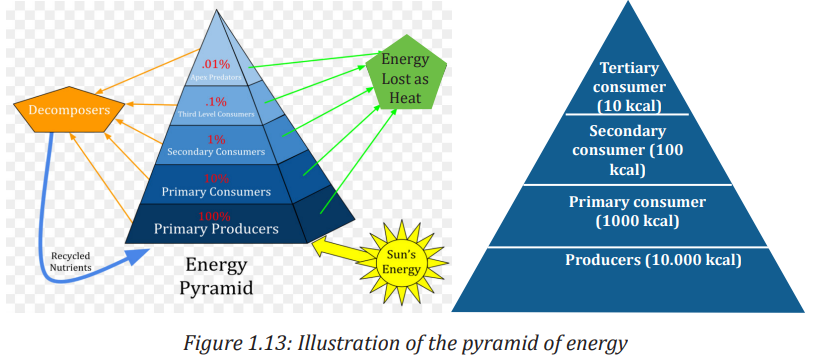
1.2.4 Limitations of ecological pyramids
While the three ecological pyramids are highly specific to the aspect of ecosystem they want to describe, all of them still tend to overlook important aspects. Some of these limitations are the following:
- These types of pyramids only are applicable in simple food chains and not for the food webs and they also do not consider the possible presence of the same species at different trophic levels.
- None of the three ecological pyramids provide any idea related to variations in seasons and climates.
- Other organisms like microorganisms and fungi are not given specific role in the pyramids despite their vital roles in ecosystems.
1.2.5. Biogeochemical Cycles
The chemical element or water moves through ecosystems. In the term biogeochemical, bio- refers to biotic components and geo- to geological and other abiotic components. During biogeochemical cycle, chemicals cycle through both biotic and abiotic components of ecosystems. For example, an element might move from the atmosphere to the water of the ocean, goes to ocean organisms, and then back to the atmosphere to repeat the cycle.
Elements or water may be held for various lengths of time by different components of a biogeochemical cycle. Components that hold elements or water for a relatively short period of time are called exchange pools. For example, the atmosphere is an exchange pool for water. It holds water for several days. This is a very short time compared with the thousands of years the deep ocean can hold water. The ocean is an example of a reservoir for water. A reservoir is a component of a geochemical cyclethat hold elements or water for a relatively longer period of time.
a. Water Cycle
Earth’s water is constantly in motion. Although the water on Earth is billions of years old, individual water molecules are always moving through the water cycle. The water cycle describes the continuous movement of water molecules on above and below Earth’s surface. Like other biogeochemical cycles, there is no beginning or end to the water cycle. It just keeps repeating. During the cycle, water occurs in its three different states: gas (water vapour), liquid (water), and solid (ice). Processes involved in changes of state in the water cycle include; evaporation, sublimation, and transpiration.
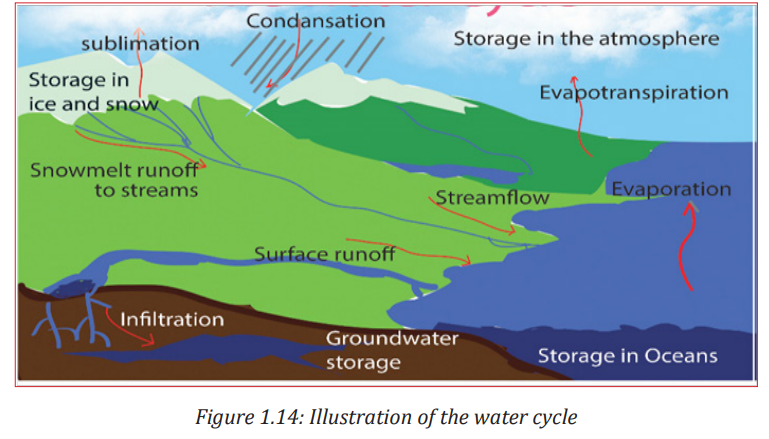
b. Carbon Cycle
Carbon is essential to all life as it is the main constituent of living organisms. It serves as the backbone component for all organic polymers, including; carbohydrates, proteins, and lipids. Carbon compounds such as carbon dioxide (CO2 ) and methane (CH4 ) circulate in the atmosphere and influence global climates. Carbon circulates between living and non-living components of the ecosystem primarily through the processes of photosynthesis and respiration. Plants and other photosynthetic organisms obtain CO2 from their environment and use it to build biological materials. Plants, animals, and decomposers (bacteria and fungi) return CO2 to the atmosphere through respiration. CO2 trapped in rock or fossil fuels can be returned to the atmosphere via volcanic eruptions, or fossil fuel combustion. The movement of carbon through biotic components of the environment is known as the fast carbon cycle.
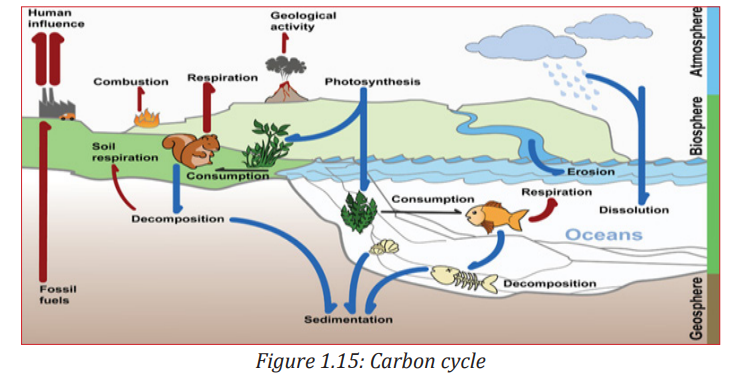
c. Nitrogen Cycle
The atmosphere is the largest reservoir of nitrogen on Earth. It consists of 78% nitrogen gas (N2 ). Similar to carbon, nitrogen is a necessary component of biological molecules. Atmospheric nitrogen (N2 ) is converted to ammonia (NH3 ) by nitrogen-fixing bacteria in aquatic and soil environments. These organisms use nitrogen to synthesize the biological molecules they need to survive. Some nitrogen-fixing bacteria live in soil, others live in the root nodules of legumes such as; peas and beans. In aquatic ecosystems, some cyanobacteria are nitrogen fixing.
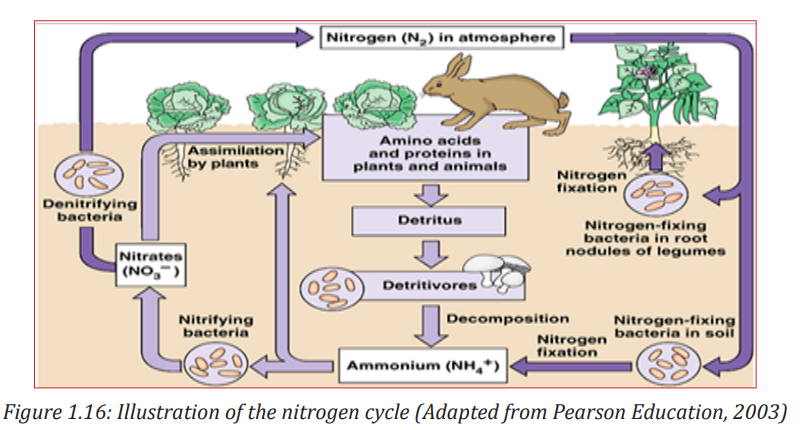

Application activity 1.2
1. a. Explain how herbivores affect their grassland environment
b. What would happen if herbivores were removed from Akagera National Park?
c. What would happen to Akagera National Park if overgrazing occurs?
2. The diagrams A, B, C and D indicate different cases of pyramid of numbers. Using your knowledge on pyramids, analyses and interpret each diagram
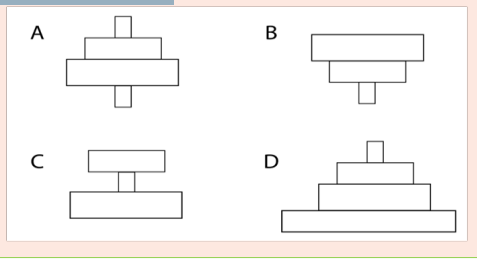
1.3 Ecological succession
Activity 1.3
Use books and search for information related to ecological succession. Describe how new species should appear on bare rocks.
Communities are not usually static, and the numbers and types of species that live in them generally change through time. This is called ecological succession. Important cases of succession are primary and secondary succession.
1.3.1 Primary succession
Primary succession occurs in an area that has never been colonized such as bare rock. This type of environment may come about when lava flows from a volcano and hardens into rock, a glacier retreats and leaves behind bare rock or when a landslide uncovers an area of bare rock.
The first species to colonize a disturbed area are called pioneer species including bacteria and lichens that can live on bare rock. These species change the environment and make the way for other species to come into the area. Along with wind and water, they help weather the rock and form soil. Once soil begins to form, plants can move in from pioneer species to intermediate stages and to climax communities (Figure 1.17). At first, the plants include herbs, grasses and other species that can grow in thin, poor soil. As more plants grow and die, organic matter is added to the soil. Soil is improved and gets the capacity to hold water. The improved soil allows shrubs and trees to move into the area.
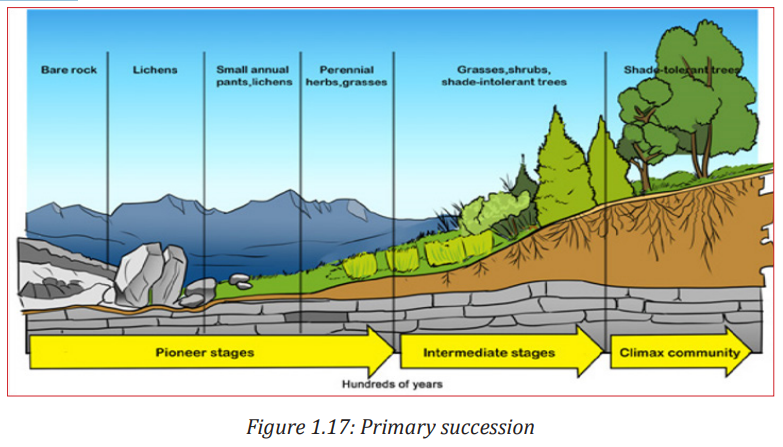
1.3.2 Secondary succession
Secondary succession occurs in a formerly inhabited area that was disturbed. The disturbance could be a fire, flood, or human action such as farming. This type of succession is faster because the soil is already in place.
In this case, the pioneer species are plants such as grasses, birch trees, and fireweed. Organic matter from the pioneer species improves the soil and lets other plants move into the area.
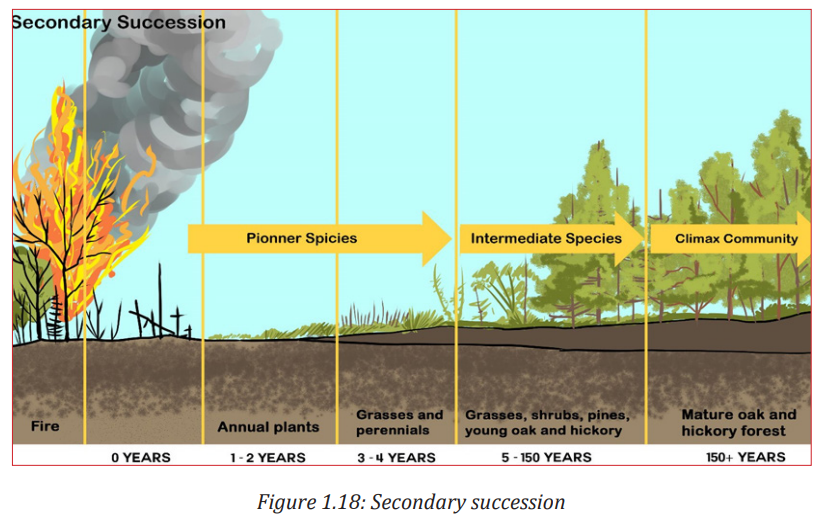
Similarities and differences between primary and secondary succession are summarized in the following table:
Table: 1.2 Comparison between primary succession and secondary succession

Application activity 1.3
How would you apply what you learned to explain why new species should appear in an area that have been disturbed by fire
1.4 Bioaccumulation and bio magnification
Activity 1.4
Use the school library and search additional information on the internet. Discuss between bioaccumulation and bio magnification
1.4.1 Bioaccumulation
Bioaccumulation refers to the accumulation of toxic chemical substances such as pesticides, or other chemicals in the tissue of a particular organism. Bioaccumulation occurs when an organism absorbs a substance at a rate faster than that at which the substance is lost by catabolism and excretion.
1.4.2 Bio magnification
Bio magnification is a process by which chemical substances become more concentrated at each trophic level. Bioaccumulors of toxic substances such as heavy metals and polychlorinated biphenyls that slowly increases up in concentration in living organisms including bacteria, algae, fungi, and plants. Bioaccumulants enter a body through contaminated air, water, and/or food, and keep on accumulating because they are very either slowly metabolized, not all metabolized, or are excreted very slowly
1.4.3 Example of the causes of bio magnification
Some toxic chemicals were deliberately put in the environment to kill insect pests. One of these pesticides is Dichloro Diphenyl Trichloroethane (DDT), which was used to control mosquitoes and other insect pests. It was commonly sprayed on plants and eventually entered water supplies. There it was absorbed by microscopic organisms, which in turn were eaten by small fish and the small fish eaten by larger fish from where it could have transferred to other animals, where it accumulates in the fat tissue of animals at the top of the food chain. This food chain shows typical concentrations of DDT found in a food chain (in parts per million, ppm):

Another biological magnification of Polychlorinated Biphenols (PCBs) was found in the food web of great lakes, where the concentration of PCBs in herring gull eggs, at the top of the food web, is nearly 5,000 times that in phytoplankton at the base of the food web.
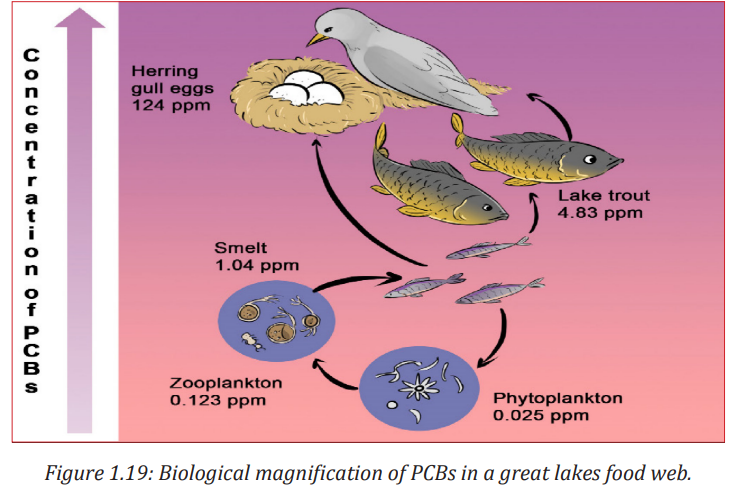
1.4.4 Consequences of bio magnification
The first sign of the problem was a decline in the number of predator birds. Studies showed that the eggs of these birds were easily cracked. In fact, the weight of the mother sitting on the eggs cracked them. It was finally discovered that DDT was building up in the tissue of the birds and interfering with the calcium needed for the shell to be hard.
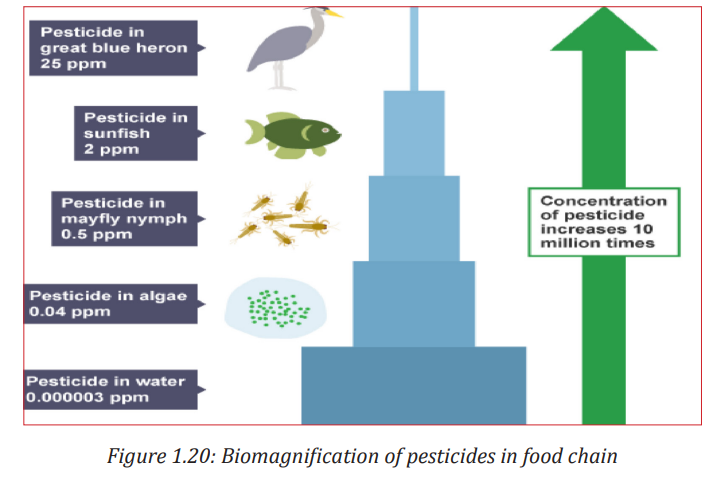
1.4.5 Prevention and reduction of bioaccumulation of toxic sub
-The following are some of the ways to prevent and to reduce bioaccumulation of toxic substances:
- Do not put harmful substances into water system or storm drains.
- Reduce the use of toxic chemical pesticides.
- Eat certified organic foods when possible.
- Avoid fishing or spending time in contaminated areas.
Application activity 1.4
In the face of biological magnification of toxins such as DDT, construct the levels of food chains where it is healthier to feed on
1.5 Efficiency of ecological production
Activity 1.5
Use the books from the school library and search further information from the internet. Discuss the roles of efficiency of ecological production and make a brief description of the ecosystem primary production, total primary production, and net primary production.
1.5.1 Efficiency of primary production
The amount of light energy converted to chemical energy in the form of organic compounds by autotrophs during a given period of time is called ecosystem primary production (R). Most primary producers use light energy to synthesize energy rich-organic molecules, which are subsequently broken down to generate adenosine triphosphate (ATP). The total primary production in an ecosystem’s gross production (GPP) is the amount of light energy that is converted to chemical energy by photosynthesis per unit time.
Note that not all of this production is stored as organic material in the primary producers because they use some of the molecules as fuel in their own cellular respiration. The net primary production (NPP) equals the gross primary production minus the energy used by the primary producers for respiration(R), as it is summarized in the following formula, i.e NPP = GPP – R.
In many ecosystems, NPP is about one-half of GPP.
To an ecologist, net primary production is the key measurement because it represents the storage of chemical energy that will be available to consumers in the ecosystem
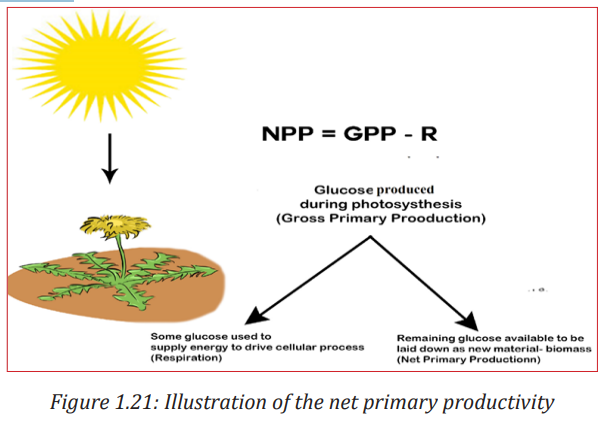
1.5.2 Efficiency of secondary production
The amount of chemical energy in consumer’s food that is converted to their own biomass during a given period of time is called the secondary production of the ecosystem. Consider the transfer of organic matter from primary producers to herbivores, the primary consumers. In most ecosystems, herbivores eat only 25 a small fraction materials produced by plants. Moreover, they cannot digest all the eaten plant materials. Thus, much of primary production is not used for consumers. In this case, the secondary production is calculated by:
Net Secondary Production (NSP) = Gross Secondary Production (GSP) – Respiration (R)
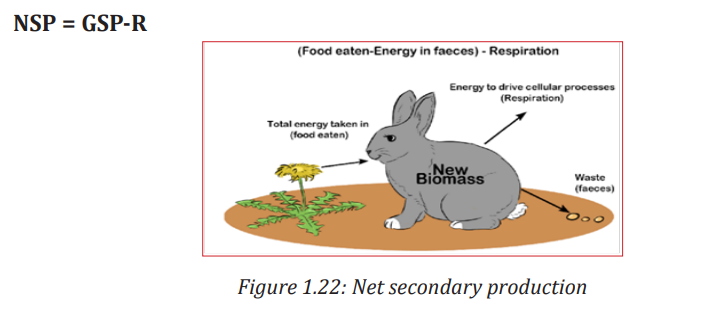
1.5.3 Ecological production efficiency
Production efficiency is the percentage of energy stored in assimilated food that is not used for respiration. It is calculated as follows:

Production efficiency is expressed in percentage (%).As an example, when a caterpillar feeds on a plant leaf, only about 33 J of out 200 J, or one-sixth of the energy in the leaf is used for secondary production or growth. The caterpillar uses some of the remaining energy for cellular respiration and passes the rest in faeces. The energy contained in faeces remains in the ecosystem temporarily, but most of it is lost as heat after the faeces are consumed by detritivores. The energy used for caterpillar’s respiration is also lost from the ecosystem as heat.
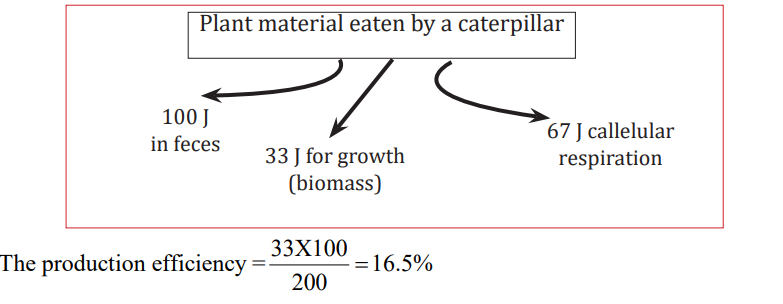
Application activity 1.5
1. As part of a new reality show on television, a group of overweight people are trying to safely lose in one month as much weight as possible. In addition to eating less, what could they do to decrease their production efficiency for the food they eat?
2. Tobacco leaves contain nicotine, a poisonous compound that is energetically expensive for the plant to make. What advantage might the plant gain by using some of its resources to produce nicotine?
3. If an insect eats plant seeds containing 100J of energy, energy from which 30 J is used for respiration while 50J remains in faeces.
a. Calculate the net secondary production.
b. Estimate the production efficiency
Skills lab 1
Being exposed to hands on and minds on activities like fieldworks either in school environment or in parks in order to observe the different species, populations, and communities related to the unit ecosystem. The various skills such as identification of species, communication have been developed.
1. All animal species found in your school and village
2. Identify and describe the plant species found in your school and village
3. Identify some areas in your school or village that should be contaminated by bioaccumulants.
Discuss your findings and write a report and present
End unit assessment 1
Section A: Multiple choice questions
Choose the letter that best answers the question or completes the statement
1. All of life on Earth exists in a region known as
a. Ecosystem c. Biosphere
b. Biome d. Ecology
2. Groups of different species that live together in a defined area make up
a. Population c. Ecosystem
b. Community d. Biosphere
3. The series of steps in which a large fish eats a small fish that has eaten algae is a) Food web b) Food chain c) Pyramid of numbers d) Biomass pyramid The total mass of living tissue at each trophic level can be shown in
a. Energy pyramid c. Biomass pyramid
b. Pyramid of numbers d. Biogeochemical cycle
4. The total mass of living tissue at each trophic level can be shown in
a. Energy pyramid c. Biomass pyramid
b. Pyramid of numbers d. Biogeochemical cycle
5. An ecosystem is not considered to be self-sustaining if
a. There is interaction between biotic and abiotic factors
b. Some of its living organisms incorporate energy into organic compounds
c. Cycling of materials occurs between organisms and their environment
d. It lacks a constant supply of energy
6. By what process do:
a. Decomposers convert organic matter into ammonia
b. Bacteria convert gaseous nitrogen into ammonia
c. Nitrosomonas convert ammonia into nitrites
d. Pseudomonas convert nitrates into gaseous nitrogen
e. Section B: Short Answer Type Questions
6. By what process do:
a. Decomposers convert organic matter into ammonia
b. Bacteria convert gaseous nitrogen into ammonia
c. Nitrosomonas convert ammonia into nitrites
6. What is the meaning of the term ecology?
7. Name the different levels of organization within the biosphere, from smallest to largest
8. How is sunlight important to most ecosystems?
9. Why is the transfer of energy and matter in a food chain only about 10 percent efficient?
Section C: Long Answer Type Questions
11. Describe the three different types of ecological pyramids.
12. Why do the rectangles in a pyramid of energy get smaller at each higher trophic level?
13. Discuss the reasons why the secondary succession is usually much faster than primary succession?
14. The table below shows mean values for primary productivity for four ecosystems: temperate deciduous forest, tropical forest, temperate grassland, and intensively cultivated land in a temperate region

a. Suggest two reasons to account for the higher primary productivity of a tropical forest compared with a temperate forest.
b. Suggest explanations for the difference in primary productivity between temperate grassland and intensively cultivated land.
c. Describe how you would estimate the fresh biomass of the producers in a grassland ecosystem.
15. The diagram shows a number of stages in an ecological succession in a lake.
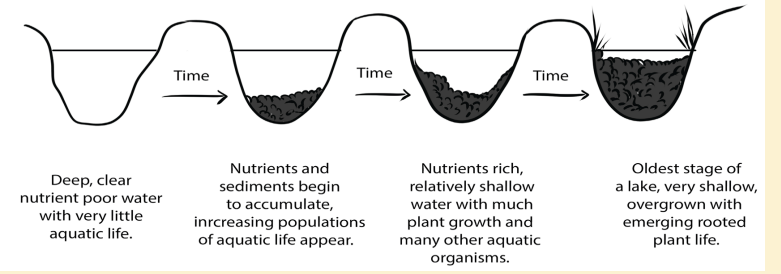
d. Use information from this diagram above and explain what is meant by an ecological succession.
e. Give two general features this succession has in common with other ecological successions.
f. A number of small rivers normally flow into the lake. These rivers flow through forested areas. Explain how deforestation may affect the process of succession in the lake.
16. Use the skills learnt in classroom and give answers to the following questions:
a. What is an ecosystem?
b. What is the required information to fully describe the make-up of an ecosystem?
c. Discuss the flow of energy through ecosystems and make a description of the various ways in which human activity can influence the energy flow at all levels in terrestrial ecosystems
17. As part of a science project, Ganza Gentil is trying to estimate total primary production of plants in a prairie ecosystem for a period of one year. Once per quarter, Ganza cuts a plot of grass with a lawnmower, do a collection and weighs the cuttings with the main purpose to estimate plant production. What is missing for Ganza to estimate the total primary production?
18. Describe the biogeochemical cycles
